enforex_pages_landing_block_1f9c8cb6-0a14-4038-9ea1-2ee5f2af179c
A Spectacular Festival in Spain
Of the numerous festivals and celebrations for which Spain is famous, the Santa Tecla Festival, which floods the streets of Tarragona, in Catalonia, with music and dance towards the end of September, is perhaps among the best. Taking place just an hour away from the cosmopolitan and cultural hub of Barcelona, and often considered a slightly smaller scale version of the main Fiesta Mayor, the Fiesta de Santa Tecla lines Tarragona's streets with 'human towers', music, and dances by mythical characters in procession, with Devils, Giants, Dragons and a Bull for folkloric allusion. The peak of the festivities involves an impressive fireworks display along the beach at nightfall. Last year's festival saw over 80,000 visitors each day descend upon the streets of Tarragona.
The Santa Tecla festival tradition began in 1321, when the relic of the arm of Saint Thecla, who was a Christian belonging to an early Christian community established by Saint Paul, arrived in Tarragona. She is patron saint of Tarragona, and is known within Tarragona as Santa Tecla. These cultural and historical foundations to the celebrations are partly responsible for the festival having been deemed a festa tradicional d'interès nacional (traditional festival of national interest). One of the most prominent and interesting aspects of the festival is the tradition of the 'castell' or human tower; these towers are constructed entirely of people standing on top of one another, and are structured and performed by colles costelleres (teams) in the Fountain Square. The Castell is usually made up of either 4 or 5 levels, and is completed when the final piece in the human tower, or the enxaneta, clambers to the top putting one hand in the air, in a gesture called the fer l'aleta signalling the completion of tower. When these human structures begin moving, they are known as the pilars caminant, and are raised up into the Cathedral square, to face the crowds and begin their 650 meter journey, aiming to keep together as a human tower, all the way down to the Ajuntament at Plaça de la Font.
Since the 19th Century, an integral part of the festival has been its main procession, brought to life by its characters, ranging from biblical figures such as Prophets, Christ and the Apostles, through to the Female Dragon Vibria, the Saint Roc Dragon, a Mule, an Eagle, a Lion and the monster Cucafera, which has, since the Middle Ages, represented evil. The Cucafera at the modern day Santa Tecla does not seem quite so saturnine however, spewing sweets from its mouth and naturally proving popular with younger visitors. This year, the Fiestas de Santa Tecla ran from the 15th to the 23rd September, with the 22nd and the 23rd being the most action-packed days of the celebrations, providing a perfect family oriented alternative, or addition, to the Festa Major, with this year's fireworks bringing the celebrations to a close on the evening of the 23rd on Fragata Beach. On the 22nd there was a plethora of traditional musicians, with the Procesion del brazo de Santa Tecla taking place the following day. The second day of the festival typically kicks off with the traditional children's parade, during which children scatter throughout the streets, performing with papier mache beasts and giants starting at 7am.
Each year, the Santa Tecla brings the entire city to life. Along with the closing fireworks, the sign usually on show next to the statue of Roger de Lluria, ablaze, which reads Long Live Santa Tecla, or in Catalan, Visca Santa Tecla confirms the festival's importance as part of the community's identity, and on a wider scale, as an embodiment of Catalan culture and tradition.
 1. The Viking Festival of Catoira
1. The Viking Festival of Catoira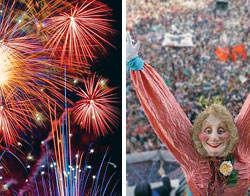 2. La Semana Grande de Bilbao
2. La Semana Grande de Bilbao 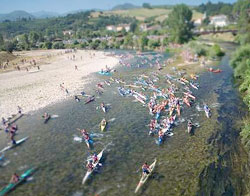 3. Descenso Internacional del Sella
3. Descenso Internacional del Sella 4. Fiestas de María Pita
4. Fiestas de María Pita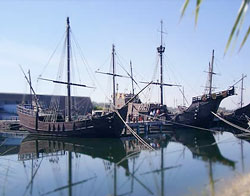 5. Fiestas colombinas de Huelva (Andalusia)
5. Fiestas colombinas de Huelva (Andalusia)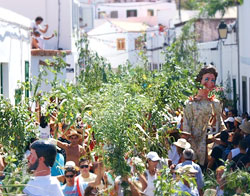 6. La Fiesta de la Rama in Agaete, Gran Canaria
6. La Fiesta de la Rama in Agaete, Gran Canaria 7. Fiestas de La Paloma in Madrid's La Latina neighborhood
7. Fiestas de La Paloma in Madrid's La Latina neighborhood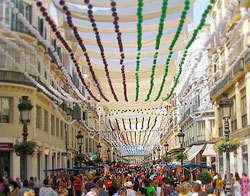 8. Feria de Málaga
8. Feria de Málaga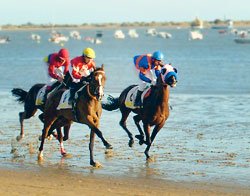 9. Carreras de Caballos
9. Carreras de Caballos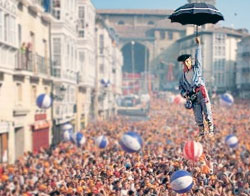 10. Fiestas de la Virgen Blanca
10. Fiestas de la Virgen Blanca